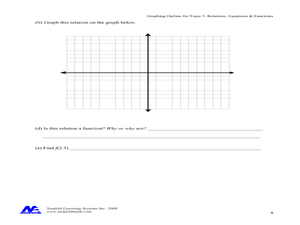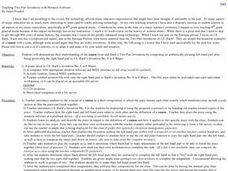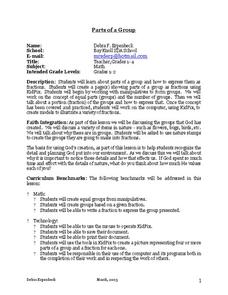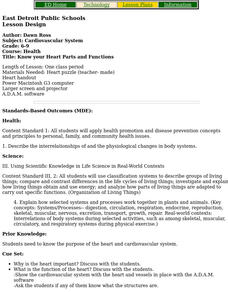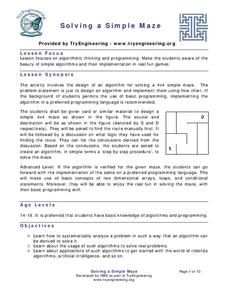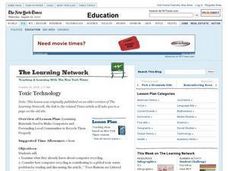Curated OER
Relations, Functions and Equations Worksheet with a Computer Component
In this relations worksheet young scholars solve eighteen problems related to relations, functions, and equations. The first part of this worksheet is designer to be completed with a computer program.
Curated OER
Teaching Two-Part Inventions with Notation Software
Students demonstrate the canon form and Bach's Two-Part Inventions by composing an aesthetically pleasing left-hand part after being given only the right hand part to J.S. Bach's Invention No. 8 in F Major. Keyboard lab suggested.
Curated OER
Body Parts of a Butterfly
Students identify the seven major parts of a butterfly. For this butterfly anatomy lesson, students explore three dimensional models of butterflies and discuss the anatomy. Students view a PowerPoint for the anatomical parts of a...
Curated OER
Parts of a Group
Students use manipulatives to form groups and then create a page showing parts of a group as fractions using KidPix. They work on the concept of equal parts and the number of groups discussing fractions of the groups and how they would...
Curated OER
Exploring the Musical Shape of Student Names in a One-Computer Classroom
Students demonstrate musical direction while singing alone and with others while reading music. They discuss and demonstrate shapes that describe the music and compare that to melodic direction. Students make music out of the letters...
Curated OER
Know your Heart Parts and Functions
Students put together a 3-D interactive "heart" puzzle and learn the names of heart parts.
Curated OER
Plant Parts
Students use "Kid Pix" to explore plants. In this science and technology lesson plan, students become familiar with plant parts and label them on a plant. Students tell the functions of each of the plant parts.
Curated OER
Jamestown Journey Part 3
Fourth graders study the economy of Jamestown. In this early settlers lesson, 4th graders read about the trade between the English and the natives in Jamestown. This lesson is part of a larger unit and coincides with the novel The Double...
Curated OER
Human Body Parts:
Students locate and label body parts. After having their picture taken with a digital camera, students cut out their body and label body parts.
Institute of Electrical and Electronics Engineers
Coloring Discrete Structures
What's the least number of colors needed to color a U.S. map? The instructional activity begins by having pupils view a video clip on continuous and discrete phenomenon, then launches into an activity reminiscent of Zeno's paradox....
Code.org
Practice PT - Design a Digital Scene
The final performance task for the unit requires class members to utilize what they have learned to create a personal digital scene. Groups work together to develop a scene and then, using top-down design, break the scene into...
Code.org
Good and Bad Data Visualizations
Good versus bad data. Pairs rate online collections of data representations from good to bad and then suggest ways to improve the visualizations. The class then creates a list of best practices and common errors in data representations...
Code.org
Image Scroller with Key Events
Discover how to embed images in lists. Scholars modify an existing app to include an image scroller in the 17th lesson of the series. They learn to refactor code and remove redundancies after modifying code.
Code.org
Practice PT - Tell a Data Story
Show your class how it all comes together. The last lesson plan in a unit of 15 has individuals take everything they learned in the data section to analyze the class-generated data. The pupils find a story they want to tell that appeals...
TryEngineering
Solving a Simple Maze
Solve a maze ... from a robot's point of view. In the lesson plan, your scholars build a small, simple maze from cardboard and then find a route from the start point to the finish point. They write an algorithmic process that a robot...
Code.org
Cracking the Code
Scholars learn how to crack secret codes as they continue reading from the Blown to Bits and try to crack the random substitution cipher. They also begin learning about the Vigenere cipher.
Drexel University
Learning Roomba Module 2: Robot Configurations
How do robots move? A presentation shows viewers the different types of configurations of that help robots move and lists the advantages and disadvantages of each of the configurations.
Curated OER
What is a Seed?
First graders identify the parts of a seed. In this plant biology instructional activity, 1st graders are given a seed and identify each part of the seed by using a hand lens. Students plant a seed and graph the growth.
Curated OER
An Eye on Science
Students investigate the human eye and its parts. They read and discuss various books about eyes and sight, draw a rough draft of an eye diagram, and create a final draft of their eye diagram including labeled parts using Kid Pix...
Curated OER
A to Zap!
Students are given a play telephone, the students correctly dial their phone number 3 out of 5 times. They use the computer program A to Zap!, students complete the telephone activity by correctly clicking on the numbers of the phone...
Curated OER
Technobasics
Students are introduced to computer rules, hardware, mouse skills, and keyboarding. In this computer basics lesson, students apply their computer skills to paint using the Kid Deluxe 4. Students also classify hardware as input...
Curated OER
TOXIC TECHNOLOGY
Students examine what they already know about computer recycling and cconsider how computer recycling is contributing to a global toxic waste problem by reading and discussing the article, ""Poor Nations are Littered With Old PC's,...
Institute of Electrical and Electronics Engineers
History of Computing – EEEEK- A Mouse!
Students examine the concepts of computer and mechanical engineering. They dissemble a computer mouse and create a new design for the mouse. They also design new enhancements for the mouse over time.
TryEngineering
Give Binary a Try!
Students apply binary code in software applications for computer engineers. For this binary code lesson, students read about binary code and its applications to computer engineers. They download software and read an online binary clock....
